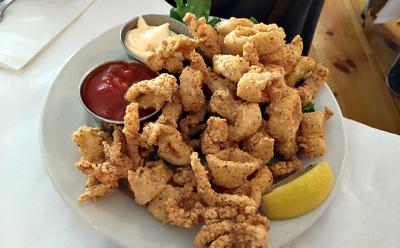Seasons by the Sea: The Skinny on Squid

When reviewing restaurants, I almost always sample their fried calamari offerings. Just about every restaurant out here has it on the menu. It’s a good test of the chef’s abilities. Is it lightly crisped and tender? Are the tentacles included? Is it served with an imaginative sauce or just a tepid marinara?
Overcooked calamari (squid) is a distressing thing to behold. Long after the crispy coating has traveled down your gullet, you are chewing, chewing, chewing the remaining rings. Visions of lobster claw rubber bands dance in your head. If there are no tentacles, I feel gypped. And while marinara is a perfectly fine accompaniment, it’s nice to find the occasional aioli, brightened with lemon or lime juice, heightened with garlic, or spiced with a judicious squirt of sriracha.
Cittanuova in East Hampton has an excellent version, served with fried zucchini strips and a tomato basil aioli. It is pale, crisp, and tender. If you fry squid more than two minutes, you will end up with the aforementioned rubbery effect. While you can do just about anything with squid — fry, saute, boil, grill, pickle, stew, smoke — it must be either cooked very quickly or low and slow for half an hour or more.
I have to admit I have never prepared squid at home. I have no problem plucking birds, butchering meat, cleaning and scaling fish, or even snipping the face off a soft shelled crab before removing its other kee-kee innards before cooking. But there’s something about the slippery, sci-fi aspects of squid that keeps me from doing the work myself.
Squid are cephalopods, along with octopus and cuttlefish. They have been a prized food in Japan and Italy and Portugal for centuries but were only considered bycatch and bait in America until about 40 years ago. When trawlers from Japan started showing up along the Atlantic Coast in the 1960s, the government and local fishermen took notice.
Because it is cheap and abundant and freezes well, it soon became so popular that it started showing up on fast food menus, rivaling the popularity of buffalo chicken wings and jalapeño poppers. In 2013, the New York catch was worth $8 million.
Sean Barrett of Dock to Dish calls our long-fin squid “a darling of versatility in the kitchen and sustainability in the ocean.” The only inedible parts are the beak and gladius (pen). It is a good source of zinc, manganese, and is high in copper, selenium, B12, and riboflavin. Squid grows fast and spawns several times a year. It is not an “apex” or alpha predator in the food chain and is low in toxins like mercury. As various factors have decimated some squid predators like sharks, tuna, and cod, the squid have been able to multiply.
North Atlantic squid can be found in waters from Newfoundland to Venezuela. There is a bridge in Newport, R.I., that is so popular for squid jigging that it has been nicknamed the Calamari Causeway.
When buying at the market, look for squid that is shiny and firm, not saggy like a deflated balloon. It should smell fresh and ocean-y. The thin, dull membrane covering it should be grey rather than pink or purple. You can buy it cleaned or tackle that job yourself. James Peterson’s encyclopedic volume “Fish and Shellfish” has thorough instructions and illustrations on how to do this.
I found it interesting that many local cookbooks don’t contain recipes for squid. Not “The East Hampton L.V.I.S. Centennial Cookbook” or “Hamptons Weekends” or “The Beach House Cookbook” or “The Hamptons and Long Island Homegrown Cookbook.” There are a few recipes in “The Seafood Cookbook” by Pierre Franey and Bryan Miller, and my favorite, “Foods of Long Island” by Peggy Katalinich, but even those keep it restricted to fried and pasta dishes.
For the adventurous cook, I recommend looking into Italian, Japanese, Chinese, and Korean cookbooks. David Chang’s “Lucky Peach” cookbook has a recipe for quickly blanched squid rings in a grapefruit salad with garlic, fish sauce, and mint. Kylie Kwong’s “Simple Chinese Cooking” has a cornstarch and flour battered squid with salt and pepper and Sichuan peppercorns that sounds so good, I might even be brave enough to try it.
Squid is versatile, inexpensive, healthy, available year round, and delicious, so don’t be a little scaredy cat like me; try some of these recipes at home.
Click for recipes
